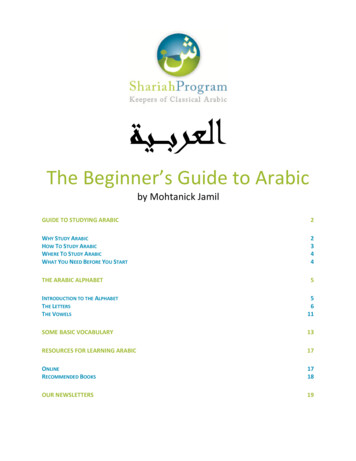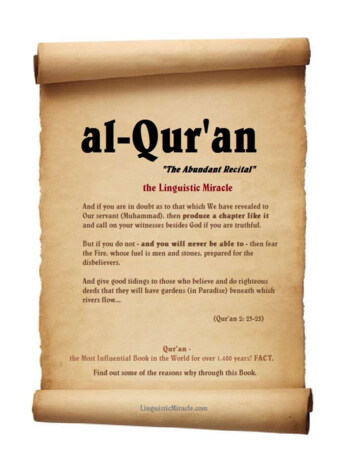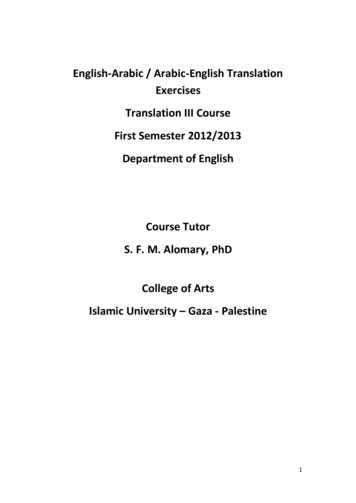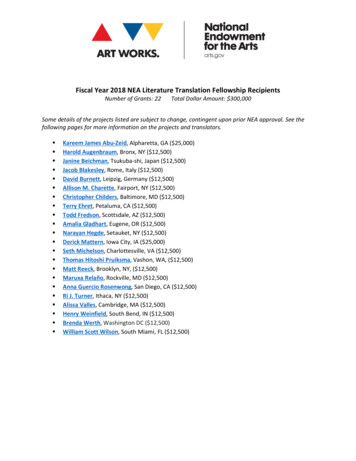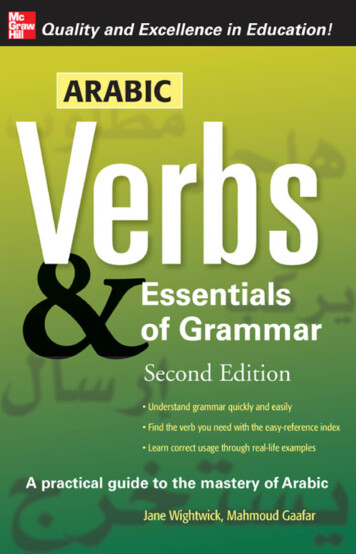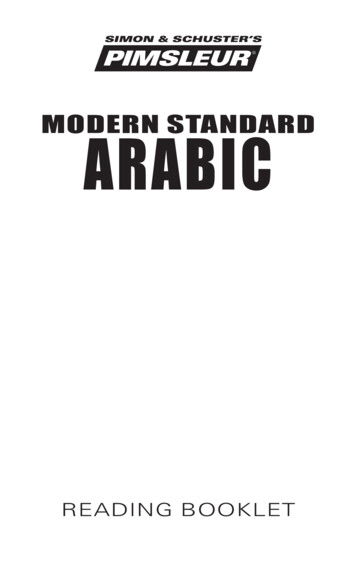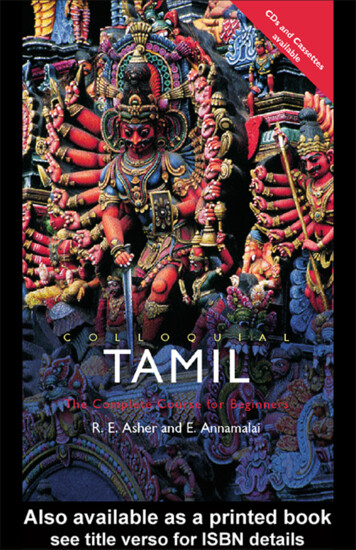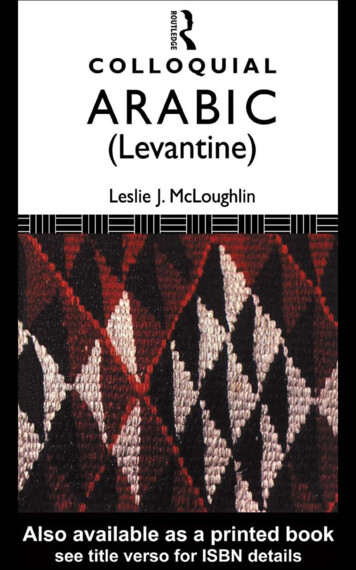
Transcription
COLLOQUIALARABIC(LEVANTINE)
The Colloquial SeriesSeries adviser: Gary KingThe following languages are available in the Colloquial series:AlbanianAmharicArabic (Levantine)Arabic of EgyptArabic of the Gulfand Saudi roatian and njabiPersianPolishPortuguesePortuguese of BrazilRomanian*RussianSlovakSloveneSomali* SpanishSpanish of Latin AmericaSwedish* ThaiTurkishUkrainian* VietnameseWelshAccompanying cassette(s) (*and CDs) are available for all the above titles. Theycan be ordered through your bookseller, or send payment with order toRoutledge Ltd, ITPS, Cheriton House, North Way, Andover, Hants SP10 5BE,or to Routledge Inc., 29 West 35th Street, New York NY 10001, USA.COLLOQUIAL CD-ROMsMultimedia Language CoursesAvailable in: Chinese, French, Portuguese and SpanishForthcoming: German
COLLOQUIALARABIC(LEVANTINE)Leslie J.McLoughlinRoutledgeLondon and New York
First published in 1982by Routledge & Kegan Paul PlcRoutledge is an imprint of theTaylor & Francis GroupThis edition published in the Taylor & Francis e-Library, 2003. Leslie J.McLoughlin 1982All rights reserved. No part of this book may be reprintedor reproduced or utilized in any form or by any electronic,mechanical, or other means, now known or hereafterinvented, including photocopying and recording, or in anyinformation storage or retrieval system, without permissionin writing from the publishers.British Library Cataloguing in Publication DataMcLoughlin, Leslie J.Colloquial Arabic (Levantine).1. Arabic language—Spoken Arabic2. Arabic language—GrammarI. Title492 .783421PJ630780–42071ISBN 0-203-13615-2 Master e-book ISBNISBN 0-203-17570-0 (Adobe eReader Format)ISBN 0-415-05107-X (Print Edition)ISBN 0-415-01854-4 (cassette)ISBN 0-415-00073-4 (book and cassette course)
CONTENTSABBREVIATIONSviiINTRODUCTION1PART ONE THE LESSONS1 Nouns and adjectives; basic sentences2 Possession and pronounsAppendix: Numbers3 Verbs, word order and demonstratives4 Verbs, conjunctions and elatives5 Participles6 Hollow verbs and ‘to be able’7 Verbs, defective and doubled8 Assimilated verbs, conjunctions and ‘for’9 Relative pronouns, verbal nouns and possession10 More verbs, verbal phrases and whenever/whoever11 Conditional sentences12 Idioms13 Terms of address and reference14 Proverbs15 Courtesy expressions for various occasions16 A story17 A miscellany18 Concepts in society19 7v
vi CONTENTSPART TWO APPENDICESKey to exercisesGrammar, indexed by lessonVocabularyBibliography121127129145
ron.sing.vbv.n.AdjectiveBritish Received PronunciationCommon (of gender)Classical ArabicColloquial ionPronounSingularVerbVerbal noun
INTRODUCTIONArabic is the language of daily communication for between 150 and200 million people, and the language of worship for many hundredsmore millions of Muslims. It is the original language of the Koran,which in Muslim belief is incomparably excellent, since it is thedirect word of God (kalaam allaah). Arabic is the language of prayerfor all Muslims, and the language of the muezzin who summons thefaithful to prayer the world over five times daily. It is now an officialworking language in the UN and many international agencies. Itsscript is used in many other languages—Persian, Ottoman Turkishand Urdu among them—and since the Koran is possibly the world’sbest selling book the Arabic script may well be the second mostused script after Latin. The Arabic written language is almostcompletely uniform throughout the Arab world. Moreover thelanguage of radio and television is uniform to the same extent, sinceit is simply the written word of modern Arabic being read aloud.There is a direct line of descent from classical Arabic, the languageof the Koran, to modern Arabic; so that across 1,400 years (in theIslamic calendar) the script is recognizably the same, the grammar haschanged remarkably little (by comparison with, for example, Germanor English) and even the vocabulary has shown an astonishing integrityand consistency. It is the Koran which has preserved the essence ofwritten Arabic, and it is also the elevated status accorded to theoriginal language of Islam which has prevented the Arabic dialectsfrom becoming as far apart from each other as the dialects of Latin.Whereas Italian and French are not now mutually comprehensible,the speakers of dialects of Arabic over an enormous area canunderstand each other. Peasants from Muscat and Morocco1
2INTRODUCTIONrespectively would certainly have problems with each other’s dialects,but even peasants and certainly educated people throughout thePeninsula, the Levant, Iraq, Egypt, the Sudan and some parts of N.Africa can make themselves understood to each other withoutnecessarily resorting to classical Arabic.Within the Levant (historical Syria, Jordan and Lebanon) there is,if not linguistic homogeneity, at least clearly visible evidence of closesimilarity between the many dialects. The differences are what onewould expect. A Sidon (Lebanon) fisherman will use differentmetaphors from those of a Syrian from the Jebel Druze; because ofclose community ties over long historical periods villages tend topreserve distinctive features of vocabulary and phonology. *This introductory manual aims to present those features of thelanguage which would be acceptable throughout the Levant area.The speech presented is not, on the one hand, the dialect of anyparticular village or area; nor is it, on the other, a debased classicalform spoken by no one in particular. The aim is to present a naturalform of speech, which is acceptable and at the same time idiomaticand correct.An Arabic proverb says ‘A new language is a new man’ and, amongother things, this means that a non-Arab approaching Arabic has tobe ready to understand (if not necessarily to imitate) different attitudesand perspectives. Westerners are not in everyday speech given, asArabs are, to quoting poetry, ancient proverbs and extracts from holybooks. Nor are they wont to exchange fulsome greetings. This is tosay nothing of the different attitudes to physical contact and proximity,as well as to relations between the sexes. It is, however, essential tounderstand not only the grammar and vocabulary of the Arabic ofthis area but also the underlying attitudes and assumptions.Perhaps the greatest difference between the Levantine approachto language and that of westerners is that Levantines, like most Arabs,take pleasure in using language for its own sake.** The sahra (orevening entertainment) may well take the form of talk alone, but*This is after all the area which gave the world the concept of a shibboleth, andthis same feature (s/sh) still distinguishes Levant dialects from each other (sajara/shajara; tree).**But in a way totally different from other Arabic speakers: five minutes on thestreets of Cairo reveal attitudes to life and language totally different from those ofSyria.
INTRODUCTION3talk of a kind forgotten in the west except in isolated communitiessuch as Irish villages or Swiss mountain communities—talk not merelycomical, tragical, historical/pastoral, etc but talk ranging over poetry,story-telling, anecdotes, jokes, word-games, singing and acting. It isno accident that Arabic has a verb which means ‘to chat to someonein the evening’ and that a common name is Samir (f. Samira) meaning‘one with whom one chats in the evening’. The moral for the nonArab is that if one can adjust to these different attitudes to language,and understand what is going on, one can discover whole layers ofArab life which must remain unsuspected to those who know noArabic or who, knowing some, remain attached to (for example) thebelief that only classical Arabic is a fit object of study. The presentwriter takes the view that a real understanding and appreciation ofcolloquial Arabic can only expand a student’s knowledge of classicalArabic.A student who understood all the allusions to poetry, proverbsand religion to be heard on a day’s march in the Levant would be farbeyond doctoral standards in terms of university study. *This manual attempts to give some insight into aspects of colloquialArabic other than syntax and vocabulary: in addition to twelve lessonson these subjects there are lessons on idioms, greetings, ritual language,terms of address and reference, proverbs, even on abuse. A multimedia approach would be necessary to do justice to a communicativeapproach to colloquial Arabic** (perhaps to any language) but thepresent volume, it is hoped, will, by presenting information in separate‘packages’ on the printed pages, prepare the student’s approach tomastering this most fascinating language.*Lebanese Arabic in particular is much maligned by some orientalists.In fact a study of its vocabulary reveals a very high percentage ofclassical vocables.**This manual has, perforce, to omit an essential element in everydayLevantine communication, namely hand gestures. An illustrateddictionary of the meanings of some hundreds of gestures could be(indeed, once was) compiled.These differ from Mediterranean handgestures (with which they show some features) in that they not onlyreinforce meaning but can also be used to hold meaningfulconversations across a distance.
4INTRODUCTIONTHE STRUCTURE OF ARABICThe following are brief notes on how Arabic works, taking tenbroad features common to both written and spoken Arabic.1 Arabic is a Semitic language (unlike Turkish and Persian), hencethe similarity to Arabic of Hebrew phrases from the Bible, e.g. Matt.27:46: ‘Jesus cried with a loud voice, saying, Eli, Eli, lamma sabachthani?that is to say, My God, my God, why hast thou for-saken me?’2 Semitic languages are distinguished by the triliteral rootsystem. The consonants k-t-b imply something to do with writing.The addition of prefixes, infixes and suffixes generates wordsconnected with writing.3 The root and pattern system in Arabic is highly developedand, being on the whole consistent and predictable, can be usedby a foreign student to guess meanings of new words and increasevocabulary.Thus, from ice, study, bureau, deskPattern always means ‘place of ’Clerk, writer, authorPattern always means the activeparticiple or doer of the actionLetterPattern always means the passiveparticipleTo correspond with someoneForm III derived verb, usually meansto do the action to someoneCorrespondentActive participle of (4) above4 Predictability Arabic has almost complete predictability in its patterns(cf. English: light/lit; fight/fought;sight/sighted). Past-tense verbs conjugatewith suffixes, for example, which are invariable for all verbs.5 Consistency in spelling(a) Words can be spelled correctly once the sound is knowncorrectly. Not for Arabic the complexities of English: seen/scene; bean/been etc.
INTRODUCTION5(b) The name of the consonant gives the consonant’s pronunciation.Haa’ is the name of the sound registered by H (cf. English:aitch h).6 Economy(a) Arabic has only two tenses, past and non-past.(b) Arabic has basically only three short vowels (a, i and u), threelong (aa, ee and oo) and two diphthongs (ay and aw).(c) In classical Arabic the short vowels do heavy morphologicalduty for verb endings, case endings and pronoun distinction,in ways which are clearly related, for example a final /i/ or /ee/ means you, feminine singular, in both verbs and pronouns.(d) In colloquial Arabic the same applies, but even more so:colloquial has almost no case endings, and verb suffixes are farfewer than in classical.7 Simplicity Particularly in colloquial Arabic,sentence structure is verysimple: for example, equational sentences have no is/are. Furthermore,Levantine Arabic like all Arabic dialects is much given to expressing agreat deal in highly truncated sentences and phrases and even singlewords. (Cf. Egyptian multi-purpose use of the word for yes!)8 Stress patterns The place of the stress—or prominence—in aword is almost completely determined by fixed rules. In broad termsthe stress falls on the first syllable except when the word has a longsyllable. Then the stress falls on the nearest long syllable to the endof the word.*9 Formality Colloquial Arabic has many ritual or formal phrases ingreeting, salutation etc. (Beware of thinking, however, that the languageis cabalistic!)10 Intonation Particular attention should be paid by students tonative speakers’ intonation: a wrong intonation is one of the clearestmarkers of a foreign accent.TRANSCRIPTION AND PRONUNCIATIONSystems of transliteration seem to vary only in degrees of repulsiveness.No one system is satisfactory to all, and the general reader is often*A long syllable is one with a long vowel or diphthong or a short vowel followedby two consonants.
6INTRODUCTIONdeterred by an excessively scrupulous attempt to render phoneticdifferences.The system employed in this book uses only the symbols foundon an ordinary typewriter. In the writer’s experience most of theapparent difficulties of using transliteration disappear when use ismade of a recording of the text (see How to use the book).Introduction to Arabic pronunciation1 Consonants and vowels The table below aims to guide thebeginner with a mixture of technical terms and layman’s language.The recordings should also be used freely.2 Stress Arabic stress rules are quite different from English, andfailure to observe this is one of the principal features of a foreignaccent.(a) short syllables have short vowels;(b) long syllables have either long vowels or a diphthong; or a shortvowel followed by two consonants;(c) in words with long and short syllables the stress falls on thenearest long syllable to the end of the word;(d) otherwise the stress is on the first syllable.Examples: mu’Hamw mad; bayróot; ána.3 Intonation One of the principal features distinguishing Levantinedialects one from another, and all from English, is the intonation, therise and fall of the voice. Students should note different intonationpatterns most carefully.A wrong intonation pattern is another commonfeature of a foreign accent.4 Junction and elision The student should note how words ‘runtogether’, in order to avoid sounding too foreign.A hyphen is intruded as a guide to pronunciation as follows:between /s/ and /h/ when these symbols represent separateconsonants, for example,’as-hal (easy).Therefore when /sh/ is writtenwith no hyphen the sound is as in English ship. Similarly for k-h/kh,t-h/th, d-h/dh and g-h/gh.An asterisk (*) in the table below indicates that the pronunciationof Levantine Arabic (in one or other dialect) may differ markedlyfrom that of classical Arabic.
INTRODUCTION7Please noteFor most occurrences in classical Arabic of the unvoiced uvular plosive(qaaf: /q/ in transliteration) the symbol /’/ is used (i.e. the symbol forthe glottal stop). Most Levantine dialects regularly make this‘conversion’ from classical Arabic, but the student should note that:123Bedouin throughout the area use /g/ for /q/,the Druzes systematically maintain /q/,certain words always retain the classical /q/: al-qur’aan (Koran)and al-qaahira (Cairo).
8INTRODUCTION
INTRODUCTION9
10INTRODUCTIONPronunciation exercisesThese are taken from proper names, i.e. names of persons and placesof relevance to the modern Arabic and Islamic worlds, and to theLevant. The tape recordings should be used a’eelkareem’ibraaheemwadee99abd us-salaam 9aarif’aHmad shuqayreemuHammad 9abd us-salaam9abd ul-kareem qaasim’ash-shaykh saalim ’aS-SabaaH ’maHmood 9abd ul-waaHidhaadee SalaaH ud-deen ’al-ayyoobee(Saladin)muHammad salmaan9uthmaan Husayn’iHsaan aheejfareed9abd un-naaSir9abd ul-laTeef baghdaadee’aHmad 9abd ullah9alee 9abd ul-laTeef9abdul-Hakeem 9aamirameer al-kooaytnoor ud-deen 9abd ulmuSTafa kamaalnaSree shams ud-deenfareed al-’aTrashmaHmood ’alhaashimeenajaat’aS-Sagheera
INTRODUCTIONnaaZim ’al-qudseesameera tawfeeq’aHmad shawqeemuHammad 9abd ul-wahhaabkaamil ’al-’as9ad11fareed shawqee9umar ’ash-shareefSaa’ib salaamyaasir 9arafaatHOW TO USE THE BOOKWithout a teacherThere are scores of possible ways of using a combination of theArabic text, the translation or key and the sound recording of theArabic, but among the possibilities are the following four step-bystep procedures for exercises and dialogues:1 Read the English; say the Arabic; hear the Arabic recording; repeatthe Arabic.2 As 1 and then: play your own voice recording; play the Arabic;correct where necessary.3 Hear the Arabic recording (at any point, i.e. in random fashion);write the translation; check and correct where necessary.4 Use the recordings for memorizing vocabulary; test yourself bycovering up the Arabic version and saying the Arabic; check fromthe recording.All sections of text which are on the cassette are marked 䊏 in the margin.With a teacherThe teacher will want to use his own methods based on experience,but the following suggestions may be useful.1 Ten drills based on the sentences and dialogues: repetition;inflexion; replacement; restatement; completion; transposition;expansion; contraction; transformation; integration. (See the author’sCourse in Colloquial Arabic, Beirut, 1974, pp. 12–14)Of these, transformation is particularly valuable for Arabic; agiven sentence can be changed for tense, negativeness, positiveness,interrogative etc.2 Random comprehension practice The teacher may use theArabic of the dialogues or the exercises for rapid-fire testing of
12INTRODUCTIONcomprehension (in random order, preferably) or for eliciting thecorrect response.3 Action and movement The teacher may have the student(s) actout the dialogues with appropriate exits and entrances when necessary.4 Recapitulation The student(s) may be asked to re-tell the storyof the dialogues and the anecdote in Lesson sixteen.5 Vocabulary testing This can be done Arabic-English or EnglishArabic using the lists in each chapter or, at a later stage, the vocabulariesat the end of the book.
PART ONETHE LESSONSLESSON ONENOUNS AND ADJECTIVES;BASIC SENTENCESFIRST, THE GOOD NEWSEquational sentences (e.g. The teacher/he is )You can communicate a great deal in perfectly correct Arabic (spokenand written) without using a single verb.1 The present tenses of to be and to have are not in the form ofconjugated verbs in Arabic (see Lesson two for to have). In factthere is no need normally to say is/are.2 The negative is formed by using one word (mush)systematically for nouns, adjectives and adverbs.3 The interrogative is formed by simply changing theintonation of the voice. Compare English: They are not here,Aren’t they here?ExamplesSalim is here—saleem hawnSalim is not here—saleem mush hawnIs Salim here?—saleem hawn?Is Salim not here?—saleem mush hawn?Karim is Lebanese—kareem lubnaaneeKarim is not Lebanese—kareem mush lubnaaneeIs Karim Lebanese?—kareem lubnaanee?Is Karim not Lebanese?—kareem mush lubnaanee?13
14LESSON ONENote The ‘Karim’ sentences illustrate that all adjectives may be usedas nouns. Indeed the classical grammarians say that the whole ofArabic grammar may be summed up in three parts: nouns, verbs andparticles.SUBJECT PRONOUNS1 c.2m2 f.3 m.3 na’intoo’intoohumhumNote (1) You and I—’ana oo ’inta. (2) Many dialects use a differentcompound form of the subject pronouns (see below, in Lesson two,‘Possession’):You and I—’ana oo iyyaak.ExamplesThey are Jordanians—hum ’urdunee-eenWe are Syrians—’iHna sooree-eenThey are the Lebanese girls—hum ’il-banaat il-lubnaanee-eenAGREEMENTAdjectives and verbs agree in gender and number with their noun orpronoun subjects in Arabic. On the other hand 1 There is no indefinite article, let alone a declined one as inmany European languages.2 The definite article does not change for gender or number.3 Plural non-humans are regarded as feminine singular for thepurposes of grammatical agreement.GENDERThe feminine adjective is formed in most cases by simply adding /a/: shaikh, shaikha; sulTaan, sulTaana; lubnaanee, lubnaaneea; urdunee,urduneea.
LESSON ONE15Adjectives formed from names, such as lubnaan/lubnaanee, bayroot/bayrootee, are called nisba adjectives (meaning relationship).When madefeminine (by adding /a/) they double the /ee/ sound.The femininenisba ending will henceforth be elubnaaneebayrooteedimashqeeFeminine The boy is Syrian—’il-walad sooreeThe girl is Syrian—’il-bint sooriyyaThe boy is a Muslim—’il-walad muslimThe girl is a Muslim—’il-bint muslimaConversely, most nouns ending in /a/ are feminine.NUMBER1 Arabic has a form for dual (two of anything) formed byadding -ayn (as in Bahrain, Alamain etc,):The two boys are here—’il-waiadayn hawnThe two girls are here—’il-bintayn hawn2 The most common plural formula (the ‘sound’ one) is thatcomposed of the adjective/noun plus -een:a Syrian—sooree (NB no indefinite article in Arabic)the Syrians—’is-sooree-een(Plurals formed otherwise—see Vocabulary—are called brokenplurals.)3 In colloquial Arabic the feminine plural ending (-aat) is notextensively used:The girls are Syrian—’il-banaat sooree-een4 The attributive adjective (e.g. ‘the Syrian girls’) must also bedefinite:the Jordanian girls—’il-banaat ’il-’urdunee-een
16LESSON ONE5 Usually a dual noun (especially with humans) will, incolloquial Arabic, have a plural adjective:the two Lebanese girls—’il-bintayn ’il-lubnaanee-eenTHE IDAFA OR CONSTRUCTThis feature of Arabic has no equivalent in English, but the rules canbe learned from simple, well-known examples.The Arabic name Dar es Salaam means ‘the abode of peace’. Noticethat the first definite article is not used.Rule 1 in the structure the of the the first definite article is notfound:the book of the boy—kitaab ’il-waladRule 2 the construct, if longer, removes all but the final definitearticle:the book of the son of the teacher—kitaab ’ibn il-mu9allimRule 3 there is no ‘apostrophe s’ in Arabic. ‘The boy’s book’ mustbe rendered ‘the book of the boy’.䊏VOCABULARYArab—9arabee (pl. 9arab)boy, son—walad (pl. ’awlaad)son—’ibn (pl. ’abnaa)girl, daughter—bint (pl. banaat)ambassador—safeer (pl. sufaraa’)teacher—mu9allim (pl. -een)book—kitaab (pl. kutub)Lebanese—lubnaanee (pl. -een)Syrian—sooree, shaamee (pl. -een)Jordanian—’urdunee (pl. -een)Palestinian—filisTeenee (pl. -een)French—faransaawee (pl. -een)English—’ingleezee (pl. ’ingleez)American—’amreekaanee (pl. ’amreekaan)foreigner—’ajnabee (pl. ’ajaanib)
LESSON ONE䊏17EXERCISETranslate:1 ’il-walad ’ingleezee2 ’il-bint faransiyya3 ’il-kitaab kitaab 9arabee4 kitaab il-bint hawn5 bint ’il-mu9allim hawn6 The boy’s teacher is a foreigner7 The foreigner’s sons are here8 The American boy is the son of the teacher9 We are the sons of the English teacher10 The Syrian girl is the daughter of the ambassadorMake the above negative and/or interrogative, where feasible.䊏 DIALOGUE: East meets westABABABAmarHaba!marHabtayn! kayf ’il-Haal?’il-Hamdu lillaah! kayf ’il-Haal?il-Hamdu lillaah! ’inta ingleezee?na9am ’ana ingleezee oo huwa amreekaanee’ahlan wa sahlan!’ahlan wa sahlan feek!TranslationA Hullo!B Hullo! how are you?A Praise be to God! How are you (How is the state)?B Praise be to God! Are you English?A Yes, I’m English and he is an AmericanB Welcome!A (Ritual reply implying that the welcome is embodied in the personextending it!)PROVERB’il-walad walad wa law Hakam balad—Boys will be boys (lit. ‘Theboy is a boy even though he rules a country!’)
LESSON TWOPOSSESSION AND PRONOUNSPOSSESSION1 The verb to have (present tense) is expressed in Arabic by sayingthat something is with /to/ in the possession of someone.I have a book—9indee kitaabThey have a book—9indhum kitaab9ind implies with/in the possession of/chez etc.The pronouns attachedto it have multiple uses: as possessive pronouns, object pronouns andas additions to prepositions.The full table is:1 c.2 m.2 f.3 m.3 f.2Singular-ee (-nee when object ofverb and followingprep, fee)-ak-ik-o-haPlural-naa-kum (or koo)-kum (or koo)-hum-humThe negative is as follows:I do not have a book—maa 9indee kitaabHasn’t she a book?—maa 9indhaa kitaab?3 my book—kitaabeetheir books—kutubhum (etc.)Note My book the book of me. The definite article disappears, asthis is a kind of idafa or construct. Attributive adjectives added to mybook etc. must be definite.my new book—kitaabee il-jadeedher Arabic book—kitaabhaa il-9arabeeNote also A refinement is introduced for nouns ending in /a/ (seeVocabulary note below).18
LESSON TWO19OTHER PRONOUN USES1you and I—’ana oo ’intaIn many Levantine dialects, however, this becomes ’ana oo ’iyyaak; i.e.the possessive pronoun is added to ’iyyaa.we and they—’iHna oo ’iyyaahum(In such phrases, pronoun order is always 1, 2 3; for example: you andthey—inta oo iyyaahum.)2 Added to h/in them—minhum/ma9hum/feehumNote from/with/in me—minnee/ma9ee/feenee3Idiomatic expressions (m. and f.):How are you?—kayfak? kayfik?How are you? (Syria)—shlawnak? shlawnik?(lit. ‘What is your colour?’)Where are you?—waynak? waynik?(often means ‘How could you say/do such a thing?’)4 Objects of verbs. The pronouns are suffixed to verbs as director indirect objects (see Lesson three).5 With kull (all), and other words:all of us—kullnaaall of them—kullhumall/the whole of it—kullo䊏VOCABULARYnew—jadeed (pl. judud) (often becomes ’ijdeed, pl. ’ijdaad) from—minplease—min faDlak (lit. ‘of your graciousness’)with—ma9in—feehouse—bayt (pl. buyoot)
20LESSON TWOschool—madrasa (f.; pl. madaaris)large, big—kabeer (pl. kibaar)small, young—Sagheer (pl. Sighaar) (often becomes’iZgheer, pl. ’iZghaar)car—sayyaara (f.; pl. -aat)man—rajul (pl. rijaal)woman—mara (f.; pl. niswaan)room—ghurfa (f.; pl. ghuraf)yes—na9amno—laaNote on possessive pronounsWhen a possessive pronoun or a noun ‘in construct’ is added to aword ending in /a/ such as sayyaara (car), a /t/ is inserted before thepronoun:my car—sayyaarateethe car of the teacher—sayyaarat ’il-mu9allim(This is the taa’ marbooTa of classical Arabic.)䊏EXERCISETranslate:1 huwa fee ghurfat ’il-mu9allim2 ’il-bintayn ma9a mu9allimee3 ’ir-rajul ’il-kabeer min 9ammaan4 9indee bintayn oo walad5 9indhaa kitaabha ’il-jadeed6 He has a new car7 She is with him in the large room8 They are all with us here9 All of us are English10All of them are foreignersMake the above negative and/or interrogative, where feasible.䊏DIALOGUE: Family newsA ’ahlan wa sahlan!B ’ahlan wa sahlan feek! kayf Haalak?
LESSON TWOABABA21’il-Hamdu lillaah! kayfak inta?’il-Hamdu lillaah! min faDlak, 9indak awlaad?na9am 9indee waladayn oo bint’il-waladayn fil-madrasa?laa! hum SighaarTranslationABABABAWelcome!And to you! (Approximately) ‘How are you?’Praise be to God! How are you?Praise be to God! Please (i.e. excuse me for asking), do youhave children?Yes, I have two boys and a girlAre the (two) boys in school?No, they are (too) youngPROVERBhaadha min faDl rabbee—This is by the graciousness of my Lord This sign, in classical Arabic, is frequently found as an inscriptionat the entrance to a house or other building.䊏APPENDIXNUMBERSConnoisseurs have long savoured Tritton’s despairing remark in TeachYourself Arabic (London, 1943), ‘The numerals are the nightmare of abankrupt financier’ (p. 171).Things are not quite so bad in colloquialArabic.1 waaHid (f. waaHida)5 khamsa2 ’itnayn (f. tintayn)6 sitta3 talaata7 sab9a4 ’arba9a8 tamaanya9 tis9a15 khamst9ash(ar)
221011121314LESSON 3The ‘intrusive’ /t/ in 13–19 inclusive.3–10 inclusive take a plural noun.11 upwards take a singular noun (but see below at Dates, timesetc.).11–19 take final /-ar/ when followed by a noun.4ExamplesThree men—talaata rijaalFive women—khams niswaanThe classical Arabic rule of masculine numeral with feminine noun(and vice versa) is not closely observed in colloquial Arabic:Sixteen books—sitt9ashar kitaabNineteen girls—tis9at9ashar ive books (5 30)—khams oo talaateen kitaabSixty-four dollars (4 60)—’arba9a oo sitteen lf (pl. alaaf9ishreen ’alf
LESSON TWO23Dates, times, etc.1979 (books)—’alf oo tis9amiyya oo tis9a oo sab9een (kitaab) (NBsingular)1910 (books)—’alf oo tis9amiyya oo 9ashara (kutub) (NB plural)the year 1945—sanat ’alf oo tis9a miyya oo khams oo ’arba9een4 o’clock—is-saa9a ’arba9a10.00—is-saa9a 9ashara10.20—is-saa9a 9ashara oo tult (a third)10.15—is-saa9a 9ashara oo rub910.30(35)—is-saa9a 9ashara oo nuSS (oo khamsa)10.45—is-saa9a ’iHd9ashar illaa rub9 (i.e. 11–1/4)2.00—is-saa9a tintayn (in some dialects)Telephone numbers are frequently divided as follows:123456—(123/456) miyya oo talaata oo 9ishreen (pause) ’arba9miyya oo sitta oo khamseenTHERE IS/AREfee (indeclinable) renders both there is and there are.The negative is maafee. In some dialects /-sh/ is suffixed. In some dialects this /-sh/ is acommon suffix added to all verbs for negation. For example:I have not—maa 9indeeshVOCABULARYeveryone—kull waaHidday—yawm (pl. ’ayyaam)week—’usboo9 (pl. ’asaabee9) (from sab9a, seven)month—shahr (pl. shuhoor)year—sana (pl. sineen or sanawaat)minute (n.)—da’ee’a (pl. da’aayi’)hour—saa9a (pl. -aat)either or, or—yaa yaa;
Haa’ is the name of the sound registered by H (cf. English: aitch h). 6 Economy (a) Arabic has only two tenses, past and non-past. (b) Arabic has basically only three short vowels (a, i and u), three long (aa, ee and oo) and two diphthongs (ay and aw). (c) In classical
